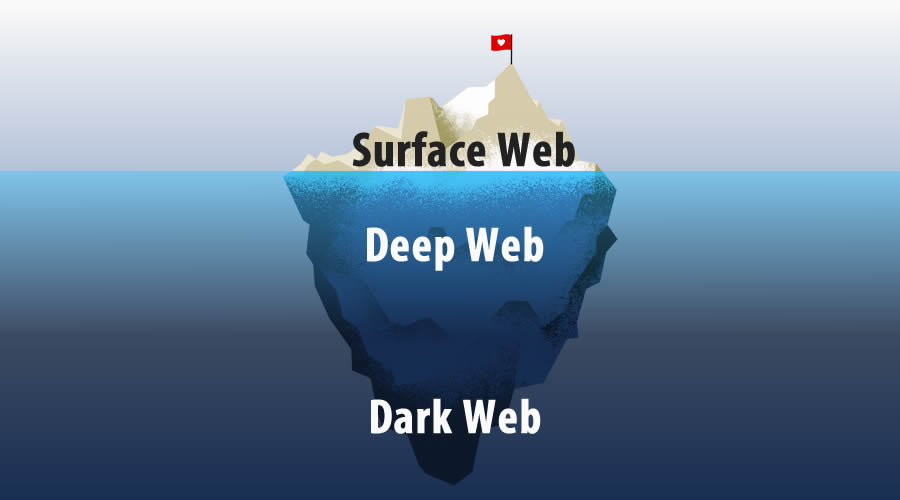Surface Web vs Deep Web vs Dark Web

It doesn’t matter whether you are a techy guy or a regular internet user; you would probably have heard these terminologies of web pages and the internet – the surface web, deep web, and dark web. If you already know about it, then it is great, but in case if you found these terms confusing (which is possible because our media has made it really confusing), then you have come to the right web page.
Here, in this article, I am going to briefly explain what these terms actually mean and how they differ from each other. Basically, I am going to explain all three different layers of the internet.
So, without any further ado, let’s get started-
Surface Web vs Deep Web vs Dark Web
There are millions of websites and web pages on the internet. If you think that you can find each of them using a Google search, you will have to think again because the internet we can access with the help of search engines is hardly around 5% of the whole internet. This portion of the internet is called the surface web.
That means the biggest portion of the internet, which is expected to be around 95%, never gets indexed by these search engines. Therefore, these web pages cannot be accessed through search engines. These web pages or websites are part of the deep web. That’s why they are called deep web sites or deep web links. If you want to access these deep web sites, you will be mostly required to have the exact URL of the webpage, Tor browser and a VPN software.
The last and the tiniest part of the internet is the dark web. Now, here things get confusing because some people classify the dark web as a part of the deep web because of the nature of the dark web, while others say that the dark web is a separate layer itself because of the content you find there. It is a never-ending debate, and trust me, they both are right, but there are few things that you need to know about the dark web, and I will talk about that later in the article.
But to have a more clear picture of all these three parts of the internet, let me discuss each in brief-
Surface Web
The surface web is the only part of the internet that gets indexed by the search engine crawlers, and due to such characteristics, it is called by many names such as index web, visible web, lightnet, etc. It is available for the general public, and it is what most internet users access in their day-to-day life.
Web pages on the surface web are easily accessible with the help of a search engine and a regular web browser. It mostly contains web pages that include blogs, search engines, many social media platforms, e-commerce websites, public forums, and other web pages available for the general public.
In addition to that, some web pages that lead to the deep web can also be found on the surface web – for example, the login page of your email account or any popular OTT platform. But mostly, web pages on the surface web contain informational data.
Deep Web
The deep web is the part of the internet that commonly resides beneath the surface web. Web pages on the deep web are purposely hidden from regular internet users, and therefore, they are not indexed by search engines. A rough estimate says that these deep web pages cover almost around 95% of the entire internet.
The majority of the deep web pages are hidden beneath the paywalls, login pages, and other closed intranet connections and security layers. It primarily contains pages containing personal information, such as your email’s inbox, access you get after login into your online banking account, streaming content available on OTT platforms, internal information of organizations, private forums, and others.
The best thing about deep web pages is that you don’t need any browser with some specific configuration to access it. These web pages are easily accessible with regular web browsers.
Even though it is very easy and considered safe to surf, you have to be cautious while accessing and entering information on these login pages. That is because phishing attacks are widespread on the deep web, and if you don’t know how to identify the real and fake web pages, you can fall for such attacks very easily.
Dark Web
The dark web is known as the darkest place on the internet because of the illicit activities that take place on this part of the web. The dark web is the tinier part of the deep web, and it is believed that it is somewhere around 0.5% of the deep web. it also cannot be indexed by search engines, and that’s why people consider it as a part of the deep web.
Unlike the deep web, the dark web uses multiple layers of encryption and traffic routing technology to offer utmost anonymity to its users. Since it provides extreme anonymity, it has become a place for illicit activities, and that is the main reason it is famous by the name – the dark web.
However, accessing the dark web is not as easy as surfing other deep web sites. You will need to set up specialized web browsers that support routing technology such as TOR Browser, I2P, Freenet, etc. these web browsers route your traffic through multiple servers so that it will become near to impossible to track you down by your IP address. That’s why many people believe that the dark web is separate from the deep web.
The majority of the dark web is about illegal black markets, forums about hacking and other darker stuff, and many indecent things that cannot be common on the surface web. Nevertheless, the dark web is not entirely about illegal things, and many journalists, activists, and other people use it as a place where they can communicate anonymously.




